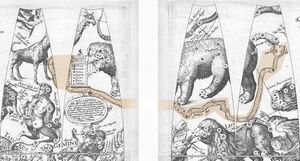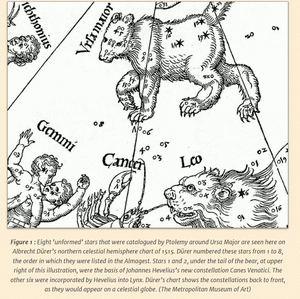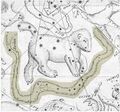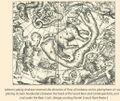Jordanus: Difference between revisions
(added content on maps showing the headwaters) |
(reversed order) |
||
| Line 49: | Line 49: | ||
The name was suggested to the IAU WGSN to be used as a star name in 2023. Alpha and Beta CVn are already named (Cor Caroli and Chara), the brightest of the others is Alpha Lyncis ([https://simbad.cds.unistra.fr/simbad/sim-basic?Ident=alpha+Lyn&submit=SIMBAD+search SIMBAD]: 3.1 mag in V). For this star, also the star name "Xuanyuan" was suggested but rejected because of the tremendous significance of this Chinese term for the Chinese cultural heritage. |
The name was suggested to the IAU WGSN to be used as a star name in 2023. Alpha and Beta CVn are already named (Cor Caroli and Chara), the brightest of the others is Alpha Lyncis ([https://simbad.cds.unistra.fr/simbad/sim-basic?Ident=alpha+Lyn&submit=SIMBAD+search SIMBAD]: 3.1 mag in V). For this star, also the star name "Xuanyuan" was suggested but rejected because of the tremendous significance of this Chinese term for the Chinese cultural heritage. |
||
In the earliest versions of the drawing of the Jordanus River, the headwaters of the river are marked by three stars, likely to be identified with 25 CVn and 20 CVn + HR 4997. Their names in late 16th-century Dutch biblical maps<ref>In 1590 Petrus Plancius designed a set of biblical maps, engraved by Johannes van Deutecom and his sons Baptista and Johannes, to illustrate a new edition of the so-called [https://nl.wikipedia.org/wiki/Deux-Aesbijbel Deux-Aes Bible] printed by the Amsterdam publisher Laurens Jacobszoon. The map of the Holy Land in this set distinctly marks the headwaters of the Jordan River as '' |
In the earliest versions of the drawing of the Jordanus River, the headwaters of the river are marked by three stars, likely to be identified with 25 CVn and 20 CVn + HR 4997. Their names in late 16th-century Dutch biblical maps<ref>In 1590 Petrus Plancius designed a set of biblical maps, engraved by Johannes van Deutecom and his sons Baptista and Johannes, to illustrate a new edition of the so-called [https://nl.wikipedia.org/wiki/Deux-Aesbijbel Deux-Aes Bible] printed by the Amsterdam publisher Laurens Jacobszoon. The map of the Holy Land in this set distinctly marks the headwaters of the Jordan River as ''Dan fons'' and ''Ior fons''. Later editions of these maps were embellished by adding a border with biblical scenes. See [https://www.biblianeerlandica.be/wp-content/uploads/4.-Plancius-1590-Beloofde-Land-1-sm.jpg example 1], [http://hdl.handle.net/10934/RM0001.COLLECT.105989 example 2].</ref> are Dan and Ior.<ref>The names ''Ior'' and ''Dan'' as the headwaters of the Jordan River appear to have originated in European pilgrim narratives and chronicles in the times of the Crusades. Cf. George Adam Smith, ''The Historical Geography of the Holy Land, Especially in Relation to the History of Israel and of the Early Church'' (New York: A.C. Armstrong and Son, 1895), p. 472 [note 1] [[https://archive.org/details/historicalgeogra1895smit/page/n503/mode/1up Internet Archive link]].</ref> Thus, it is proposed to name one, two or all three stars within the obsolete constellation: |
||
# α Lyncis: "Jordanus", ([https://simbad.cds.unistra.fr/simbad/sim-basic?Ident=alpha+Lyn&submit=SIMBAD+search SIMBAD]: 3.1 mag in V) |
# α Lyncis: "Jordanus", ([https://simbad.cds.unistra.fr/simbad/sim-basic?Ident=alpha+Lyn&submit=SIMBAD+search SIMBAD]: 3.1 mag in V) |
||
Revision as of 10:31, 14 September 2024

An obsolete Early Modern constellation made from eight unnamed Ptolemaic stars: Alpha and Beta CVn, Alpha, 31 and 38 Lyncis (according to Toomer), and three fainter stars of uncertain identity.
Etymology and History
It is the name of a (real) river with immense cultural significance, not only as a border between countries but also for several religions. The English word is a Latin loanword, derived from Semitic 'Yard|on' 'flow down' <√ירד reflecting the river's declivity (Hebrew: נְהַר הַיַּרְדֵּן, Nəhar hayYardēn, Arabic: نَهْر الْأُرْدُنّ, Nahr al-ʾUrdunn).
Constellation
The extinct constellation "Jordanus Fluvius" or "Jordanis" – the river Jordan – was invented by Petrus Plancius on his 1612 celestial globe.[1][2][3] The constellation first appeared in print in the book Usus Astronomicus Planisphaerii Stellati by Jacob Bartsch (1624), as his 26th constellation – "Iordanis" or "Iordanus". In the illustration of "Iordanis" on Bartsch's celestial globe Planisphaerium Stellatum... (1661), the star Alpha Lyncis appears as one of the prominent stars in the middle of the constellation. The extinct constellation also appeared as "Iordan" on Isaac Habrecht's (1628) Planiglobium coeleste et terrestre, "Fluvius Jordanis" in Carel Allard's (1708) Planisphaerii Coelestis Hemisphaerium Septentrionale and "Ior-Dan" in Corbinianus Thomas' (1730) Mercurii philosophici firmamentum firmianum. John Barentine (2016) notes that most of the area of Jordanis (and its aliases) was carved up in Hevelius's Lynx, Leo Minor, and Canes Venatici, which were subsequently adopted as constellations by the IAU in the 1920s.
Occurrence in historical maps and globes
- van den Keere, Pieter & Plancius, Petrus 1612, celestial globe.[4]
- Bartsch, Jacob, 1624, Usus Astronomicus Planisphaerii Stellati, p. 57.
- Habrecht, Isaac, 1628, Planiglobium coeleste et terrestre, Figura I.[5]
- Cellarius, Andreas, 1660, Harmonia Macrocosmica, Plates 24, 25 & 26.[6]
- Royer, Augustin, 1679, Cartes du ciel reduites en quatre tables.[7]
- Brunacci, Francesco, 1687, Planisfero del Globo Celeste Arctico & Antarctico.[8]
- Coronelli, Vincenzo, 1692, Planisfero Settentrionale, corretto, et accresciuto di molte Stelle,[9] also on his celestial globes dated 1693 & 1696.[10]
- Allard, Carel, 1708, Planisphaerii Coelestis Hemisphaerium Septentrionale.[11]
- Thomas, Corbinianus, 1730, Mercurii philosophici firmamentum firmianum, Frankfurt/Leipzig.
Transformation of Constellation
The eight 'external' stars south of Ursa Major in Dürer's star chart 1515, described by Ian Ridpath (highlighted by SMH).
Jordanus constellation (highlighted) in Habrecht, Isaak, Planiglobium coeleste ac terrestre (1666).
Image of the river with its direction of flow reversed by Johann Ludwig Andreae (1724) with description by Ian Ridpath
Mythology / Cultural Significance
The Jordan River. Modified from MAP Cross-checked with other maps, especially in the area of the Hula swamp and the tributaries (see Wikicommons).
IAU Working Group Star Names
The name was suggested to the IAU WGSN to be used as a star name in 2023. Alpha and Beta CVn are already named (Cor Caroli and Chara), the brightest of the others is Alpha Lyncis (SIMBAD: 3.1 mag in V). For this star, also the star name "Xuanyuan" was suggested but rejected because of the tremendous significance of this Chinese term for the Chinese cultural heritage.
In the earliest versions of the drawing of the Jordanus River, the headwaters of the river are marked by three stars, likely to be identified with 25 CVn and 20 CVn + HR 4997. Their names in late 16th-century Dutch biblical maps[12] are Dan and Ior.[13] Thus, it is proposed to name one, two or all three stars within the obsolete constellation:
- α Lyncis: "Jordanus", (SIMBAD: 3.1 mag in V)
- 25 CVn: "Ior" (SIMBAD 4.82 mag) for the sake of symmetry, perhaps also BH CVn (SIMBAD 4.94-5.1 mag VSX), but on some maps explicitly only one star here
- 20 CVn + HR 4997: "Dan" (SIMBAD 4.69 mag, SIMBAD 4.94 mag)
The WGSN chose ... (not to apply/ to apply the name to a neighbouring star/ to ...) in the IAU-CSN.
Weblinks
Reference
- ↑ Ridpath, Ian, "Star Tales: online edition".
- ↑ Barentine, John C., 2015, The Lost Constellations: A History of Obsolete, Extinct, or Forgotten Star Lore, Springer Praxis Books LINK, Chichester, UK, p. 201-216.
- ↑ Harper, David & Stockman, L.M., 2020, "Jordanus Fluvius – The River Jordan",
- ↑ Rijksmuseum link.
- ↑ ECHO link.
- ↑ Alvin link 1, Alvin link 2, Alvin link 3.
- ↑ Gallica link 1, Gallica link 2.
- ↑ Gallica link.
- ↑ Gallica link 1, Gallica link 2.
- ↑ Gallica link 1, Gallica link 2.
- ↑ Rijksmuseum link.
- ↑ In 1590 Petrus Plancius designed a set of biblical maps, engraved by Johannes van Deutecom and his sons Baptista and Johannes, to illustrate a new edition of the so-called Deux-Aes Bible printed by the Amsterdam publisher Laurens Jacobszoon. The map of the Holy Land in this set distinctly marks the headwaters of the Jordan River as Dan fons and Ior fons. Later editions of these maps were embellished by adding a border with biblical scenes. See example 1, example 2.
- ↑ The names Ior and Dan as the headwaters of the Jordan River appear to have originated in European pilgrim narratives and chronicles in the times of the Crusades. Cf. George Adam Smith, The Historical Geography of the Holy Land, Especially in Relation to the History of Israel and of the Early Church (New York: A.C. Armstrong and Son, 1895), p. 472 [note 1] [Internet Archive link].






















